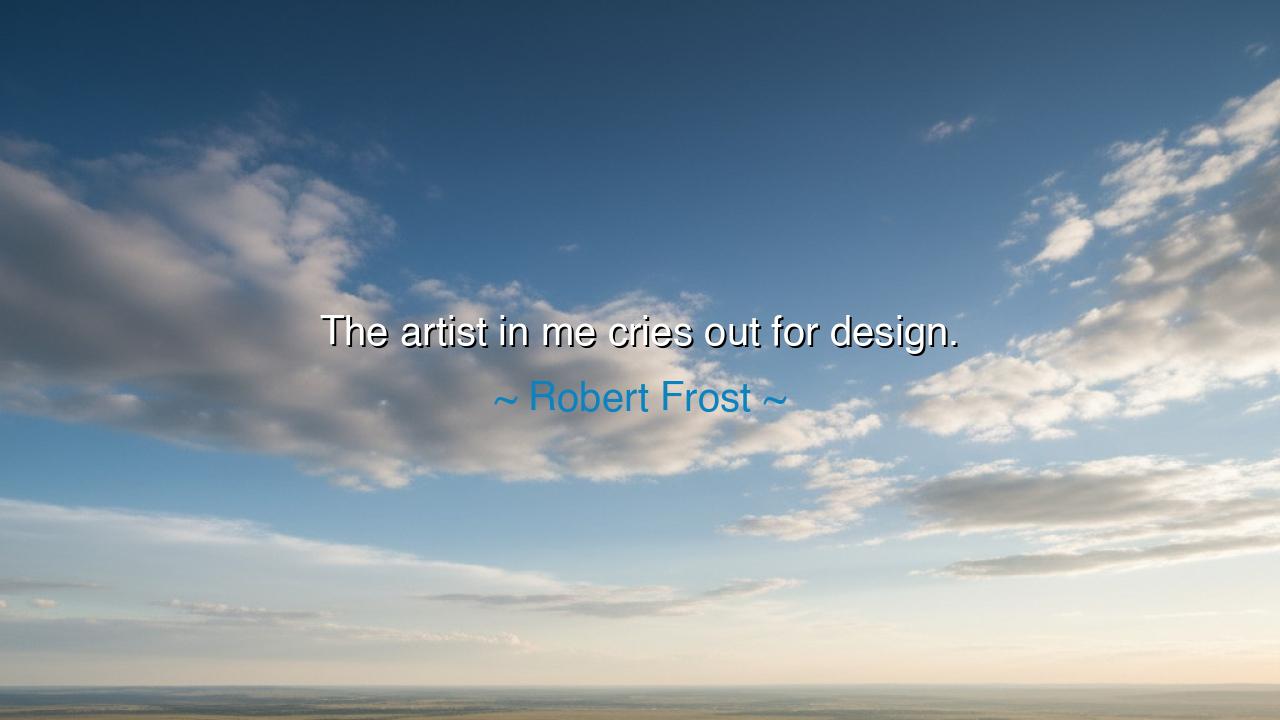
The artist in me cries out for design.






“The artist in me cries out for design.” — Robert Frost
Thus spoke Robert Frost, the poet of stone walls and snowy woods, whose words carried both the quiet of the earth and the thunder of the soul. In this brief and haunting declaration, Frost reveals the eternal tension within the act of creation — the pull between inspiration and order, between the wild chaos of imagination and the sacred structure that gives it form. When he says, “The artist in me cries out for design,” he is not calling merely for arrangement or symmetry, but for meaning — for a pattern within the vastness of existence, a purpose behind beauty, a reason beneath wonder.
The origin of this quote lies in Frost’s meditation on the mysterious design of the natural world. In his poem “Design,” he contemplates a small, chilling scene: a white spider on a white flower holding a white moth — a perfect, terrible harmony of color and death. “What but design of darkness to appall?” he asks, questioning whether such a pattern can exist without purpose. Here, Frost reveals both awe and anguish. The artist in him marvels at the perfection of form — the whiteness upon whiteness, the balance of light and doom — yet the thinker in him trembles before the possibility that design might belong not only to beauty, but to suffering as well. His cry for design is thus a cry for understanding — for clarity amid mystery, for structure amid chaos, for sense amid sorrow.
This longing is as old as art itself. From the builders of the pyramids to the poets of the Renaissance, artists have sought design — the divine blueprint that turns creation into communication, that transforms the raw into the meaningful. The sculptor who shapes marble, the composer who arranges sound, the painter who orders color — all obey the same ancient impulse: to find order in the swirling storm of experience. For the true artist does not simply imitate life; he interprets it, finding in its randomness the echo of intention. In this way, Frost’s cry becomes universal — for who among us has not looked upon the chaos of the world and longed to see purpose woven through its pain?
Consider the story of Leonardo da Vinci, that titan of both art and science. His notebooks reveal a mind torn between curiosity and order, between the boundless and the precise. He dissected the human body to learn its design, believing that beauty was born not of chance, but of geometry and proportion. To him, the curve of a muscle or the flight of a bird was not random — it was music written in matter. Like Frost, Leonardo’s artistry cried out for design, for a unity between what the heart feels and what the intellect perceives. And like Frost, he found both wonder and torment in that search — for to glimpse design is to glimpse the hand of eternity.
Yet Frost’s cry is not only the yearning of the artist — it is the yearning of the human soul. Every person who struggles to make sense of loss, to find peace in a world of disorder, feels the same ache. We are all artists of our own days, shaping from the raw clay of experience something coherent, something that holds meaning. To cry out for design is to say: I wish to understand why things are as they are. It is to seek pattern in the patternless, to believe that beauty and purpose are not illusions, but truths waiting to be revealed through patience, craft, and reflection.
The lesson is this: chaos is the raw material of creation, but it is design that gives it life. Let your passions flow freely, but do not let them consume you; shape them as the artist shapes stone. In your work, your words, your relationships — seek design. Ask yourself not only what you feel, but what meaning lies within that feeling. For beauty that endures is not wild emotion left unchecked, but emotion refined by understanding. The river of inspiration must find its banks, or it floods the land; but with guidance, it becomes a mirror for the heavens.
So remember the teaching of Robert Frost: “The artist in me cries out for design.” Let that cry echo within you whenever the world feels senseless, whenever your thoughts scatter like leaves before the wind. For to cry out for design is to affirm your belief that life itself is art, that meaning can be shaped even from suffering, that truth can be carved from the stone of confusion. Seek your design not in perfection, but in purpose — not in control, but in harmony. And when you find it, even for a moment, you will know the peace Frost glimpsed: the peace of a world that, though vast and mysterious, is bound together by beauty and intent.






AAdministratorAdministrator
Welcome, honored guests. Please leave a comment, we will respond soon